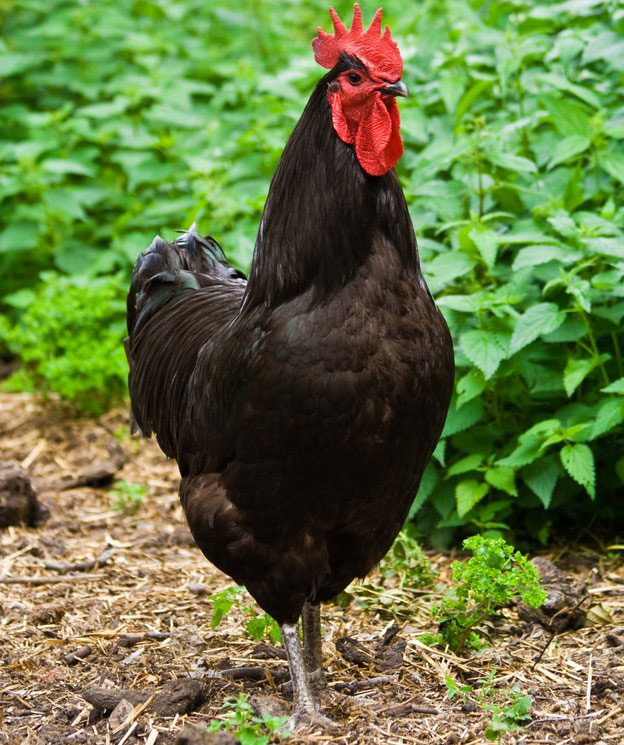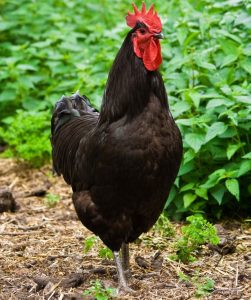
Australorp and Black Jersey Giant chickens look and behave a lot alike. Both are good foragers, and the hens of both breeds tend to become broody and raise their own chicks. Both breeds have a bright red single comb, red earlobes, a black beak, and dark brown eyes.
Australorps come in one color — black. Jersey Giants can be black, blue, or white. Black, of course, is the variety most likely to be confused with Australorp. Below are seven differences between Australorps and black Jersey Giants.
Origin
Australorps originated in Australia, where they are called Australian Black Orpingtons. They were bred for egg production rather than meat. The American Standard of Perfection lists them in the English class. Although they were bred along similar bloodlines to the Orpington breed, Australorps don’t look much like Orpingtons. To avoid confusion with the Orpington breed, in the United States the name was shortened from Australian Black Orpington to Australorp.
Jersey Giants originated in the state of New Jersey, developed as an alternative meat bird to the turkey. Jersey Giants are slow growing, requiring some 8 to 9 months to reach a good size and proportion for the table. The Standard of Perfection lists them in the American class. The original color was black, and the original name for the breed was Black Giant. The name was later changed to Jersey Giant in honor of their state of origin, according the Livestock Conservancy.
Size
The average mature Australorp hen weighs 6-1/2 pounds. The average mature Australorp rooster weights 8-1/2 pounds. Compare that to the weight of the average mature Jersey Giant hen at 10 pounds, and the average mature Jersey Giant rooster at a whopping 13 pounds! The Jersey Giant, in fact, is our heaviest chicken breed. Size, however, might not be helpful in identifying which is which unless you are comparing two of the same sex and age side-by-side.
Eggs
An Australorp hen lays large eggs with tinted (light brown to pink) shells. An Australorp hen’s rate of lay for the first year or two ranges between 200 and 280 eggs annually. According to the Livestock Conservancy, an Australorp hen once set a world record by laying an amazing 364 eggs in 365 days. Being good layers, excellent foragers, and a dark color that reduces the chance of attracting predators, Australorps are popular for pastured egg production.
A Jersey Giant hen lays extra-large eggs with brown to dark brown shells. The average production rate ranges from 175 to 185 eggs per year, although Jersey Giants bred specifically for production lay somewhat better. Hens in Cackle Hatchery’s production-bred line may lay as many as 260 eggs per year.
Broodiness
Hens of both breeds tend toward broodiness, although the larger size of the Jersey Giants makes them somewhat clumsy and more liable to accidentally break eggs in the nest. Since broodiness reduces the rate of lay, production lines of both breeds are bred to be less broody. Interestingly, the extra-large eggs of the Jersey Giant can take a day or two longer to hatch than eggs of Australorps and other chicken breeds.
Appearance Differences
Although at first glance the two breeds look much alike, a closer inspection reveals significant differences. The Australorp has white skin. The shanks and toes are dark slate. The undersides of the feet are pinkish white to grayish. The Jersey Giant’s skin is yellow. The shanks and toes are black to dusky yellowish-green. The undersides of the feet are yellow.
According to the Standard of Perfection, the comb of an Australorp rooster or hen is supposed to have five well-defined points, with the one in front smaller than the other four. The comb of a Jersey Giant rooster or hen is supposed to have six well-defined points, evenly serrated. But in real life, the comb of any breed often does not precisely fit the standard description.
Climate Tolerance
Both being large breeds with heavy feathering, Australorps and Jersey Giants are cold hardy. The Australorp, however, is heat tolerant, while the more massive Jersey Giant is much less so.
Temperament
Australorps tend to be more active than the mellower Jersey Giants, yet despite their large and potentially intimidating sizes, both breeds are known to be docile and gentle. So, when the decision is between Australorps and black Jersey Giants, you can’t go wrong — either breed makes a good choice, even for the novice chicken keeper.
And that’s today’s news from the Cackle Coop.
Gail Damerow, author, The Chicken Encyclopedia



The Jersey can have pinkish bottoms to the feet but it is considered a fault. It doesn’t make them any less a Jersey giant as other aspects (comb, size, egg colour) are all Jersey characteristics. They just cant be used as show birds and should not be bred
Being a wandering Joisey Jerk, The Jersey Giant bred on the other side of the state from where I grew up, is a bit of a family bird. In the Forties and early Fifties we often had a Jersey Capon when guests were expected. My maternal grandmother actually preferred the capon to our Swift turkey, so we had both. I think the Jersey Giant capon actually might have been sweeter because when I went back for seconds I always asked for the Capon. Times change, Ahh, times change.
Australorps are called Australorps in Australia too. They also come in blue and splash – and white! They are considered duel purpose, eggs and meat.